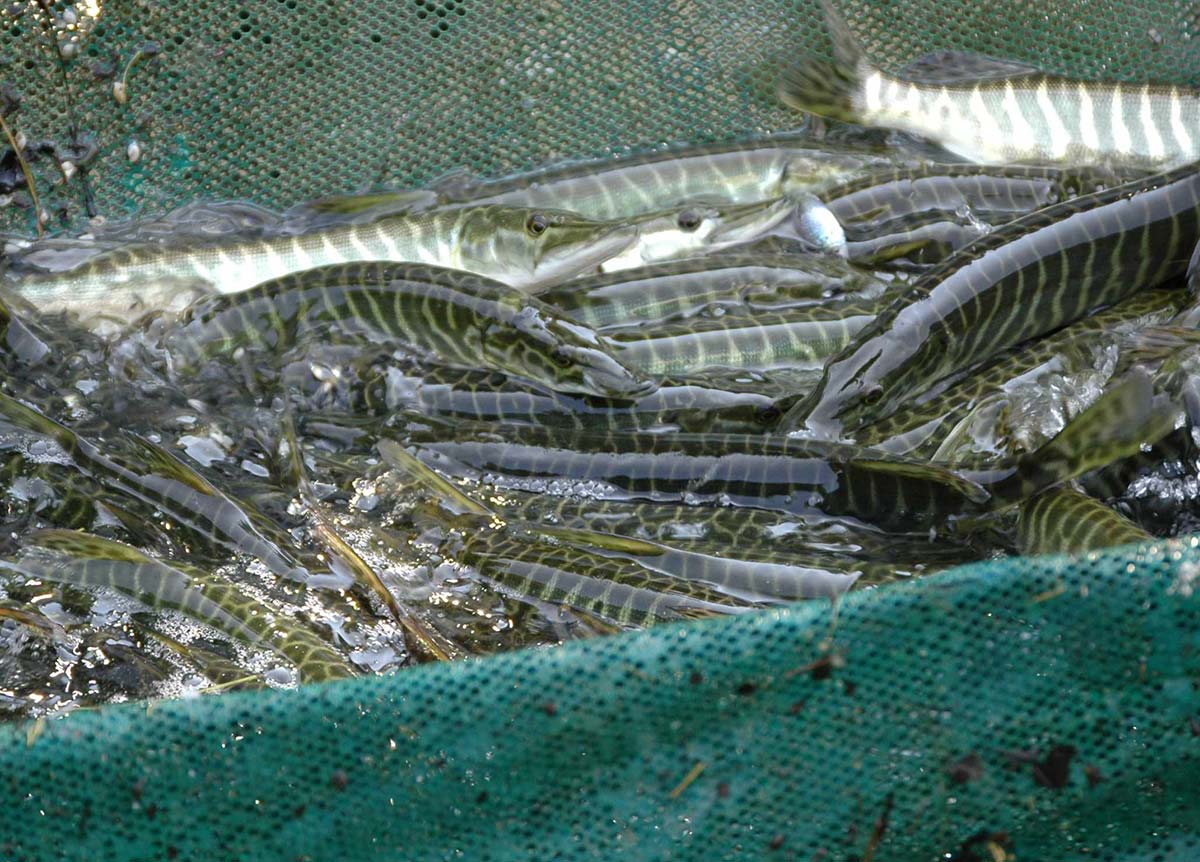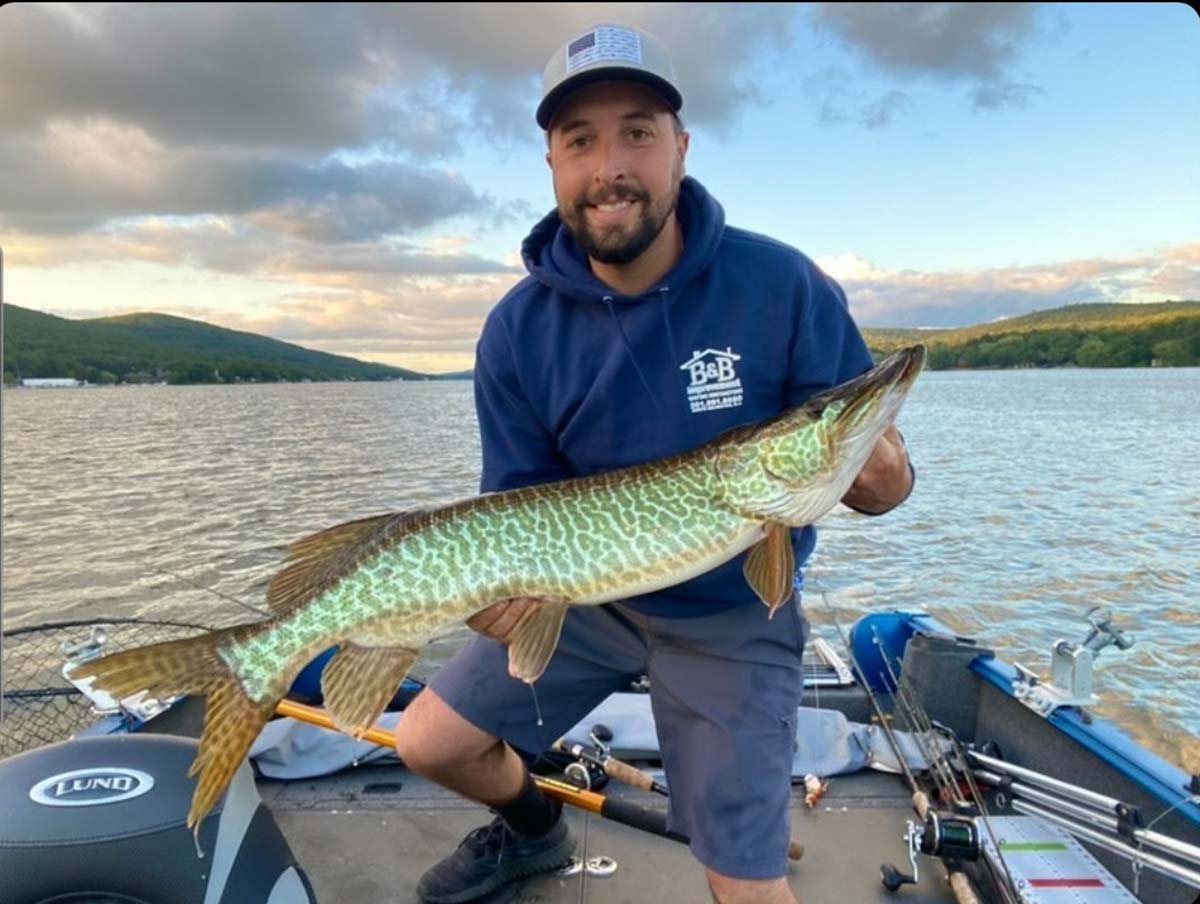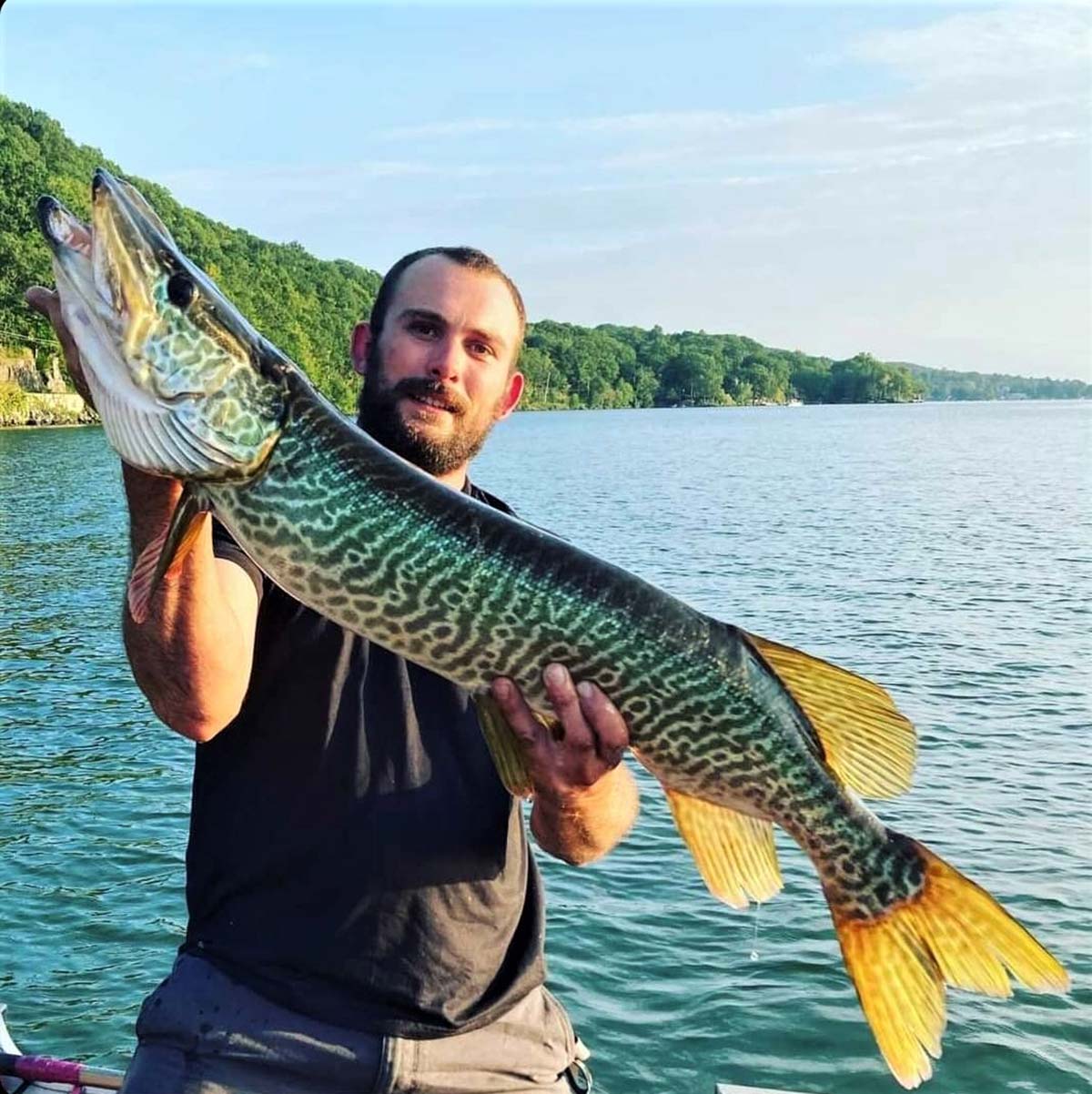
What do you get when you cross a muskie with a northern pike? Pure adrenaline!
Finny years swim quickly by.
It was in late spring 1979 when I was at the small public access fishing area on Budd Lake along Shore Drive with New Jersey principal fisheries biologist Bob Stewart. I was a newly hired wide-eyed fisheries worker just getting my gills wet. We had several buckets containing tiger muskellunge fingerlings, 10 inches of “hangry” going by their collective facial expression that we’d picked up at the Charles O. Hayford Hatchery in Hackettstown.
These were to be released into the lake (Budd is a natural lake, not an impoundment) as the genesis of a pilot program for raising northern pike and pure strain muskies in a hatchery environment. A critical component was that the latter pair be receptive to eating dry feed. The tigers, a cross between the two, readily took to the pellets, and the process was underway. We watched the 20 or so tigers slowly disperse, some heading out to deeper haunts while others took positions along the shoreline. Later, Spruce Run Reservoir would also become a recipient of this hybrid species.
Fast forward a dozen years, perhaps a couple of more, and the tiger muskie’s ability of survive in a variety of environments and its “catchability” made it popular among the angling esocid set (Esocidae is the family of fish which contains muskies, pike and pickerel). Way bigger than pickerel, more numerous than the virtually non-existent pike, and now just as numerous, if not more so, than its pure strain muskie parent. Plus, it was proving not as difficult to catch as the “Fish of 10,000 casts” with tigers in the double-digit pound class being documented throughout the Garden State.
Tiger Timeline
Tigers were released in numerous waters, 19 in all, and in an effort to get a trophy esocid fishery established in the southwestern tier counties; they were also freed in a couple tidal tributaries of the Delaware River such as the Rancocas Creek. Unfortunately, the southern effort fizzled as sampling revealed little if any tigers on the prowl, most likely having migrated into the Delaware itself for richer forage grounds.
By the early years of the new century, the Hackettstown Hatchery had the netting, propagating, rearing and raising of both pure strain muskies and northern pike down pat, and stocking muskies in 11 (including the DOD Lake and Cooper River Park Lake in the south) and six venues respectively. Surplus muskies are released periodically in the Delaware River, with extra northerns stocked in Cranberry Lake and Deal Lake.
The tiger was slowly but surely being relegated to third string status. Growing legions of pure strain muskie and northern pike fans made this inevitable. Both the latter attain bigger sizes (New Jersey’s state record muskie is 42 pounds 13 ounces, and the northern pike mark is 30 pounds; the top tiger comes it at a close 29 pounds) and are more of a fit in a wider variety of venues.
Still, the tiger is hanging on and is testament to the Bureau of Freshwater Fisheries recognizing that yes, it definitely has a place – albeit it a greatly reduced one – in the freshwater fishing scheme of things. But strictly from an aesthetic point of view, with perhaps the exception of the rare wild bred tiger (brown/brookie) trout, the tiger muskie may be the most visually stunning fish on the wide ranging roster.

Bowl Baby
The tiger, an interspecific hybrid in fisheries lingo, begins its life in a stainless steel bowl, the spawn of either a male muskie and a female northern pike, or vice versa. Although there is some evidence that it can reproduce in the wild with either another pike or muskie, for all intents and purposes, one would rate it 99.99% sterile, same as the hybrid striper.
After the necessary swirling and fertilization, the eggs are transferred to hatching jars for a 12-day stay, then to 350-gallon round tanks for one week. With the fry’s yoke sacs consumed, it’s off to a 1000-gallon rectangular tank for four to five days where they’ll be fed dry mash then progressing to pellets. The final stop is a 2000-gallon rectangular tank where they are still fed pellets until a few days before stocking when they are treated to a diet of fathead minnows to get them used to what they’ll encounter in the wild. The rate of growth is rapid.
“Tigers are pretty easy to raise, and that’s why we started with them long ago before the pure strains and northerns to get the procedure down,” said Craig Lemon, the superintendent of the Hackettstown hatchery. “They accepted dry food from the start. And they grow quickly, faster than the pike or pure strains. Tigers hatch a couple of weeks after the pike and will pass them by after a few months,” Lemon added.
Life expectancy is shorter than either pure strain parent, as is typical with hybrids of all stripes, with 10 to 12 years, give or take a year or two, being about it. As with anything else, there are exceptions. Quality habitat, cool water and ample forage are the primary factors in the survival and growth of this first level predator.
Appetite Driven
Tiger muskies will reach the average 10- to 12-inch stocking size within five months. In their new environs they immediately start chowing on minnows, shiners and small panfish, as well as other unfortunates such as frogs and crayfish. From there, the inches and girth come quickly. Once they get in the mid 20-inch range, considered adult size and still growing, they’ll take whacks at stocked trout; in this case, lakes Hopatcong, Furnace and Musconetcong, the only venues receiving rainbows where there are tigers in residence. As such, an average 10- to 10-1/2-inch stockie is a subsurface prime rib.
Ditto suckers, chubs, larger panfish (yellow perch a fave), gizzard shad, and yes, yearling and young adult bass, be they largemouth or smallmouth. Juvenile shad descending the Delaware in the fall? Elephants eat peanuts, too. In fact, no fish is immune to the maul and maw of a tiger, which, like its escocid kin, is the quintessential ambush feeder.
As with the other members of the escocid family, weeds are favored cover; but the tiger can also be encountered around stumps, sunken brush, and similar subsurface structure. In rivers they like to station along sunken logs and boulder breaks out of the main flow, eyeballing all creatures great and small moving by. Blink of an eye killing strike potential, and concealment, ultimately determine the respective holding area.
What goads strikes from pure strain muskellunge will do the same to its half breed kin. One noted trait of the tiger is that it is still a willing feeder when warming waters, usually by mid-June and into the summer, give muskies lockjaw. Mark another point of popularity for the hybrid. The Fisherman Magazine contributor and bass nut-turned-muskie maniac Lou Martinez observes that while both species bring something to the table and present their own set of challenges, it’s the tiger that provides more of a chance of contact during this period.
It’s Lou’s contention that yet another selling point of the tiger is its propensity to blast a spinnerbait, much more so than a pure strain. He prefers a tandem blade set up with a Colorado blade and a long willow leaf. “Lots of water displacement that sends out lots of vibration,” said Martinez, while advising “Let it drop then lift it and start a retrieve, boom!”

They’re Great!!!
Trolling plugs, working big glide, crank and jerk baits, and trolling and casting monster spinners like the Mepps Musky Killer and Magnum Musky Killer can help you earn your stripes. Casting and retrieving these over-sized offerings is a wrist and shoulder workout (read: have a tube of Blue-emu handy that evening) and makes a strike that much more rewarding.
The daily limit is one fish at a minimum of 40 inches. It’s a one muskie deal, either tiger or pure strain. It’s a 44-inch minimum length, and a one muskie rule, on the designated Trophy Muskie Waters which include Lake Hopatcong, Echo Lake Reservoir (Newark Watershed; access permit required), Monksville Reservoir, and Greenwood Lake.
Tigers have also been set free in Manasquan Reservoir, Furnace Lake, and again in Camden County’s Cooper River Park Lake. The Delaware River remains the top choice for encounters as per the stockings by the Pennsylvania Fish & Boat Commission as well as ancillary entries by of special interest is the concerted 5-plus-year effort attempting to establish a viable Tiger Muskies only fishery in Morris County’s 329-acre weed-infested Lake Musconetcong. The venue’s pH, structure and cover is prime, as is the forage base, and, save for stocked trout and largemouth bass, angling pressure is minimal.
According to a source at New Jersey’s Bureau of Freshwater Fisheries, an impoundment is stocked annually with two tigers per surface acre. That equates to 658 10- to 12-inch yearling tigers. To date, that correlates to at least 3,290 hybrids that have been on the chomp, and indications point to a stellar trophy hunting experience.
| MORE ON MUSKIES |
| Information regarding the Garden State’s muskie fishing opportunities, both pure strain and hybrid, can be obtained by visiting www.njfishandwildlife.com, or by checking the likes of the outstanding organization, Muskies Inc. Chapter 22 at www.mi22.com. |
“That’s a big fish,” Lemon said when I asked of the possibility that the existing 29-pound state record tiger muskellunge taken in the Delaware would be soon surpassed. “But I think Hopatcong or Greenwood or, again, the Delaware River could produce a new record,” said Lemon, adding “Lake Musconetcong could be sleeper with the forage base it has, but the fish need a few more years for that.”
The future of the tiger muskie’s place in the Garden State’s freshwater fishing scene is stable, albeit on a limited scale, and it looks as if it will remain so for the next few years at least. It fills niche between its parental fisheries, and certainly deserves a review insofar as an expansion of waters.



